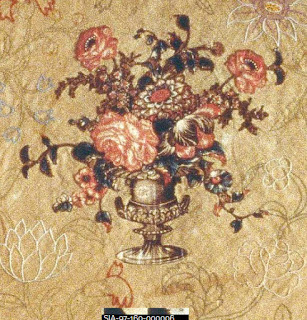Several mid-century chintz quilts feature floral arrangements in this
silver urn in the center of Sarah V.C. Quick's quilt, once in the
collection of the McCarls.
I'm guessing the footed vase supposed to be silver as it looks metallic
and has a noticeable white highlight on the left side with initials
("AN" perhaps those of the engraver.) Quilts with the fabric are date-inscribed
from 1842 to 1852.
The Benton County Oregon Museum owns a pieced quilt with the yardage as a border.
We can see a rose in the vase and a passion flower floating off to the left.
The Quick quilt's vase seems transferred whole from the print.
Others add and subtract.
In the center of a chintz quilt in the collection of the Genessee Valley
Museum in New York
From the Freehold Baptist Church, Monmouth County, New Jersey, dated 1852.
Collection of the International Quilt Study Center & Museum
Along the left side in a quilt pictured in William Dunton's
book Old Quilts, found in Baltimore in the Clark family
The highlight makes it fairly easy to spot.
Some times it's featured and hard to miss as in Sarah Quick's quilt.
And the 1843 album from the Boardman family in the
Los Angeles County Museum of Art
1846. Ladies of the Third Presbyterian Church, Philadelphia
Philadelphia Museum of Art
1844 Anna E.W. Sterling, Trenton, New Jersey
in Nancy & Donald Roan's book Lest I Shall Be Forgotten
The yardage must have been valuable enough that even the incomplete repeats were saved.
Parts used in this quilt dated 1843 from Trenton and the
Vallette, Coleman, McNeely & Aitken families
from a Pook & Pook auction
156 blocks in this quilt!!!
Carolyn Ducey noticed those vase parts in her dissertation
Note two fragmented vases in the Pratt family quilt in the
Denver Art Museum collection
One might suspect that one seamstress was making use of the fragments, perhaps a professional needlewoman who made the most of her scraps, stitching or basting blocks for customers who contributed to different quilts.
The more I look at these chintz quilts the more I see professional seamstresses and/or designers who made the whole fashion possible. How would you get 156 stitchers up to speed to make such consistent blocks?
An imaginary quilt block shop in Philadelphia in 1843
Is this the print in another colorway?
A bronze vase rather than silver
From the center of a quilt by Mary Pleasants Younghusband Brooke,
Brooke Grove, Maryland
Collection: NMAH at the Smithsonian
A yellow colorway?
Is this the original ca 1840 print or a later repro?
Mary Koval did a reproduction print a few years ago in a
collection called Remember Me.
Same highlight
Different initials:
MLK for Mary Koval, the designer































So interesting. That 156-block quilt is amazing!
ReplyDelete